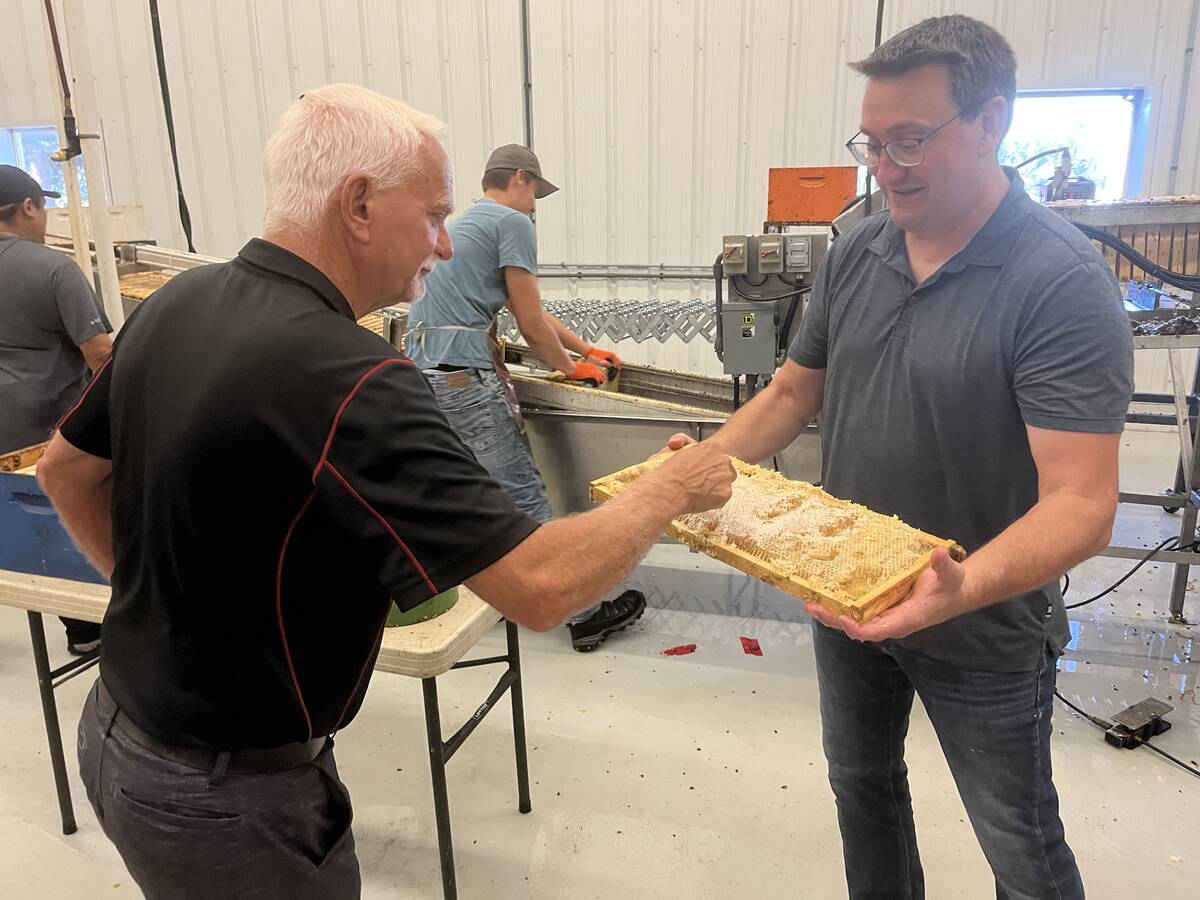Bill and I will be leaving in a couple of days to spend two months in Mesa, Arizona. One problem with going away is missing the activities at home. But the activities available there will replace the ones left behind at home and before we know it, we’ll be on our way back home.
Dear TEAM: Some time ago (possibly a few years) I clipped a reci-10-P. for Picardy tarts from the cooking column of the newspaper, possibly Emmie Oddie’s? I’ve managed to lose it. The tiny tarts are made from dried apricots and topped with a special meringue. My granddaughters think they are “awesome.” – J. K., Sundre, Alta.
Read Also

Alberta honey business ‘thrives’ despite bumpy beginnings
Thrive Honey showcases its honey production in market where Alberta produces 40 per cent of all honey produced in the country
Dear J. K.: I’m sorry we weren’t able to find this recipe until after Christmas. However, I’m pleased to say The Western Producer was able to find it on file in Emmie Oddie’s Feb. 18, 1993, column. –
Picardy’s apricot tarts
Pastry:
2 cups all-purpose 500 mL
flour
1/2 teaspoon salt 2 mL
1/2 cup icing sugar, 125 mL
sifted
1 teaspoon baking 5 mL
powder
3/4 cup shortening 175 mL
(part butter)
1 egg
1 tablespoon milk 15 mL
apricot filling (see below)
marshmallow topping
(see below)
candied cherries
Apricot filling:
2 cups dried 500 mL
apricots
11/2 cups water 375 mL
3/4 cup sugar 175 mL
juice of half a lemon
pinch of salt
Marshmallow topping:
1/4 cup lemon gelatin 50 mL
powder
1/4 cup boiling water 50 mL
1 egg white
3/4 cup sugar 175 mL
2 1/2 tablespoons water 38 mL
1 teaspoon corn syrup 5 mL
pinch of salt
Preheat oven to 425 F (220 C).
To prepare crust: Sift flour, salt, icing sugar and baking powder together into a bowl. Add shortening and cut in coarsely. Beat egg and milk together with a fork; add to flour mixture and blend lightly with fork until dough sticks together and leaves sides of bowl.
Form dough into small balls, about one inch (2.5 cm) in diameter, and press into 36 small tart tins, pressing to sides to form a shell. Prick bottoms of shells with a fork. Bake about 10 minutes or until browned. Cool on rack.
To prepare filling: Cut apricots in small pieces. Combine with water in a saucepan, bring to boil. Reduce heat and simmer until apricots are mushy. Press through a sieve (or use blender) to form a puree. Return to saucepan, add sugar, lemon juice and salt. Heat, stirring until sugar is dissolved and mixture is thick. Spoon into baked tart shells.
To prepare marshmallow topping: Dissolve gelatin in boiling water and set aside. Combine egg white, sugar, water, corn syrup and salt in top of double boiler. Set over boiling water and cook, beating constantly, about five minutes or until mixture holds firm peaks.
Beat in dissolved gelatin mixture. Remove from heat and continue beating until mixture cools and forms firm peaks. Place a spoonful of topping over apricot mixture and decorate with a piece of candied cherry.
Makes about three dozen small tarts.
Lead warning
Health Canada is advising Canadians about potential danger of exposure to lead that may be in inexpensive jewelry typically purchased for children, and candles that have lead core wicks.
Lead is hazardous to human health. Even small amounts of absorbed lead can be harmful, especially to young children, infants and unborn babies. Children can absorb lead by sucking or chewing on inexpensive jewelry. Lead can also be absorbed by inhalation during the burning of candles with lead core wicks.
Lead is found in both imported and Canadian-made jewelry, and it is sold in various retail outlets.
These items are available in a variety of shapes and sizes and may be metal plated or coated with enamel.
Health Canada completed a nationwide marketplace survey of inexpensive jewelry that typically sold for less than $20.
Laboratory results reveal that most of the jewelry contains high proportions of lead: 66 of the 95 samples collected had a lead content ranging from 50 percent to 100 percent.
Absorbing even low amounts of lead may have harmful health effects on the intellectual and behavioral development of infants and young children.
Health Canada has tested a random sampling of candles with metallic core wicks available in the Canadian market. Most candles containing lead core wicks came from China.
Candles manufactured in Canada and the United States are less likely to contain lead core wicks.
An estimated 10 percent of candles available in Canada have lead core wicks. Before buying candles ask the retailer about the wick.
For candles already in your possession, you can tell if they have a lead core wick by following three steps:
- Remove any wax from the tip of the wick.
- Separate the fibre strands from the wick to see if the candle has a metallic core.
- If the candle has a metallic core, rub the core on a piece of white paper. If the mark left on the white paper is grey, the metallic core is probably lead.
















